See sunspots with your unaided eye using this simple method. We also have news on a bright supernova!
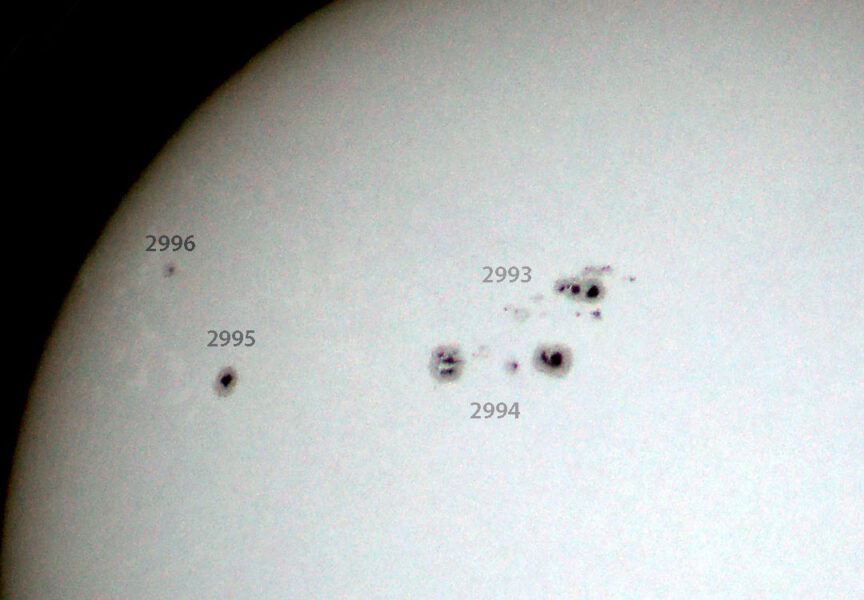
Bob King
I'm a passionate naked-eye sunspot observer. No telescope or binoculars needed. I use eclipse glasses or a #14 welder's glass to safely scrutinize the solar disk for black imperfections that betray the presence of large active regions on the Sun's photosphere.
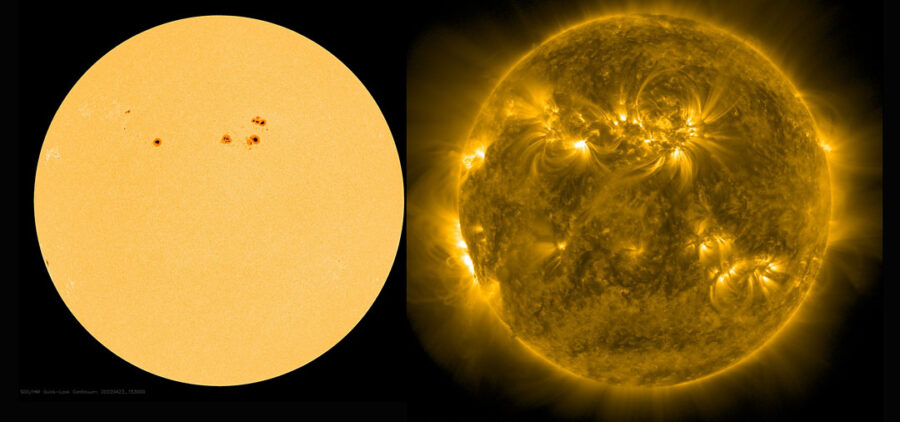
NASA / SDO
I often start with a quick look through my small, filtered refractor to identify likely prospects before attempting a naked-eye observation. But a telescope isn't necessary. You can go to NASA's Solar Dynamics Observatory site and scroll past the far-ultraviolet (UV) solar images and click on the orange and yellow HMI Intensitygrams for timely, visible-light images of the Sun that resemble the view in a small instrument. If a sunspot looks large, grab your glasses for a look. My favorite tool is the #14 welder's glass. The standard size is 4.25 × 2 inches, perfect for a relaxing view. Straining with one eye to look through a smaller filter reduces visual acuity.
My own measurements reveal that I can resolve a single sunspot or sunspot group as small as about 0.9′ to 1′ across or approximately 1/32th of the Sun's diameter — equal to between 41,360 – 43,500 kilometers (25,700 to 27,000 miles) or roughly 3.2 – 3.4 Earth-diameters.
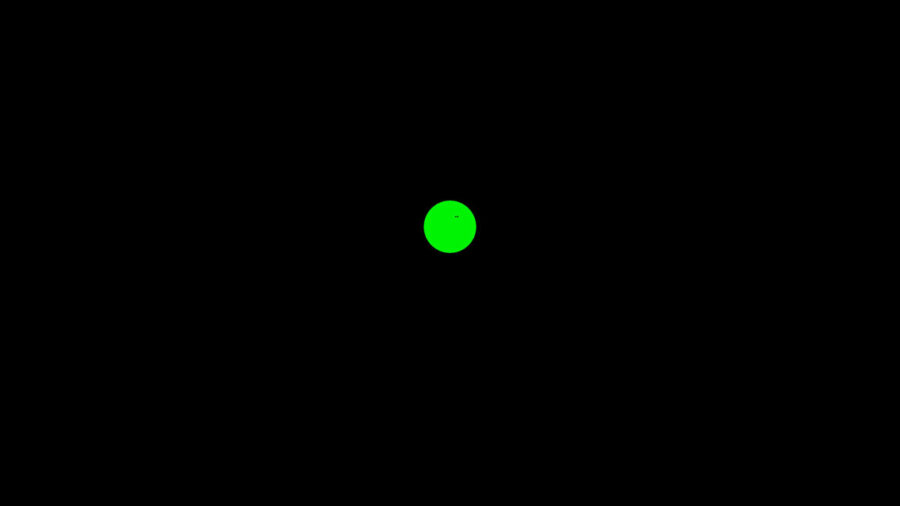
Bob King
Sunspots this size appear as tiny but distinct black flecks on the bright disk. Don't be surprised if you have to use averted vision to confirm a sighting. It works in the daytime, too! Larger spots, which are not uncommon especially during the current upswing in the solar cycle, are immediately obvious as inky dots reminiscent of Ganymede's plump shadow transiting Jupiter.
The largest groups can easily measure a dozen Earth-diameters or more. The grand champion, observed in April 1947, grew to more than 36 times Earth's diameter with an area of 6,132 millionths of a solar hemisphere. Sunspot areas are measured in millionths, so a spot with an area of 1 millionth would cover 0.000001 times the area of the Sun's facing hemisphere.
Skinny sunspots
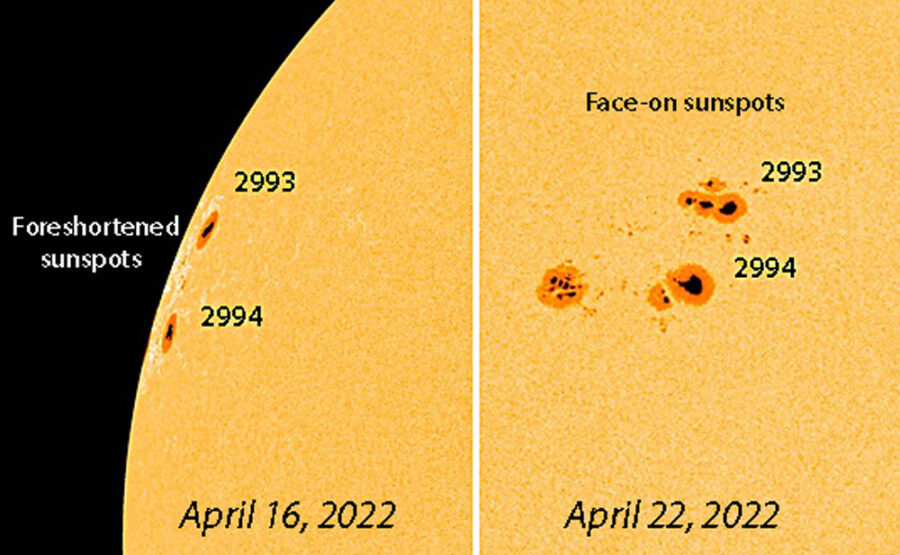
NASA / SDO
Since March, larger sunspots have become increasingly common. Whether they're visible with the naked eye or not depends upon where on the solar disk they appear. We can't escape the fact that the Sun is a sphere. The closer a spot or region is to the limb the more "squished" or thinner it appears due to foreshortening. Compressed spots are much more difficult to see than those located near the Sun's central meridian. Even spots 4–5 Earth diameters wide are difficult naked-eye objects when they're more than 40° of longitude from the center of the solar disk.
As a group rotates closer to the meridian, foreshortening decreases and we face them square-on and bigly, the same way we view lunar craters along the terminator at first and last quarter phases.
Latitude also affects a spot's appearance but less so than longitude. At this time in the current solar cycle, most sunspots appear within a band 25° to 30° wide on either side of the equator. As the cycle approaches maximum (predicted for July 2025), they'll huddle closer yet to the solar waistline. Reduced foreshortening coupled with peak activity should increase the number of sunspots visible without optical aid.
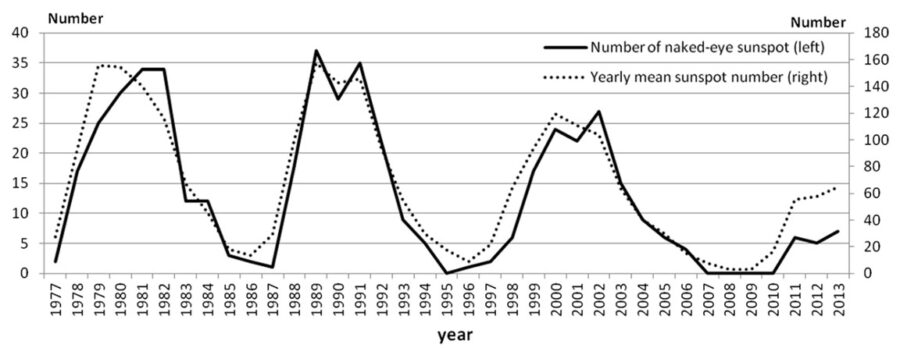
Earth Planet Sp 67, 82 (2015); Hayakawa, H., Tamazawa, H., Kawamura, A.D. et al. / NASA and WDC-SILSO / Royal Observatory of Belgium data
It takes an average of about 14 days for a sunspot to rotate from east to west across the Sun's facing hemisphere. When near the Sun's limbs, sunspots appear to move more slowly across the disk because most of their motion is along our line of sight. As they approach and cross the solar meridian, they cross our line of sight, and their apparent motion accelerates. Despite foreshortening (line-of-sight) limitations it's possible to observe a larger spot or group without optical aid for at least a week.
Peas and sesame seeds
Long before the invention of the telescope, Chinese court astrologers observed and recorded larger sunspots, giving them colorful, descriptive names like "black spots as large as plums" or comparing them to peaches and hens' eggs. Spots must have been bigger back then because they look more like peas and sesame seeds now!
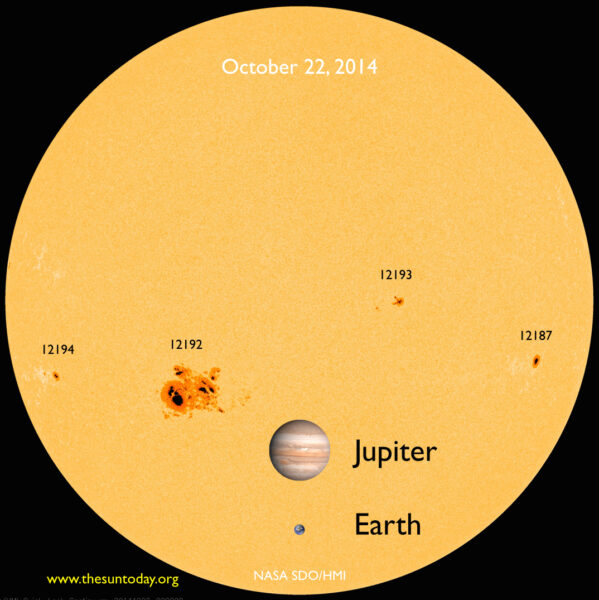
C. Alex Young / TheSunToday.org
I like knowing the size of a sunspot, especially the naked-eye variety. At public astronomy events, dimensions give the attendees a better grasp of the enormity of solar features and the Sun itself. The measurement process itself is straightforward. If a group appears within about 25° of the solar center, foreshortening is minor. With photo in hand, you can use the Ruler Tool in basic imaging programs like Paint (packaged with Windows, type Paint in the search box) or Photoshop Elements to measure the width in pixels of both the solar disk and a selected sunspot.
You can use your own images or one of the multiple, daily photographs captured by NASA's orbiting Solar Dynamics Observatory (SDO). At the link, scroll down the left-hand column to the bright yellow HMI Intensitygram-flattened photo. Click and save it to your hard drive.
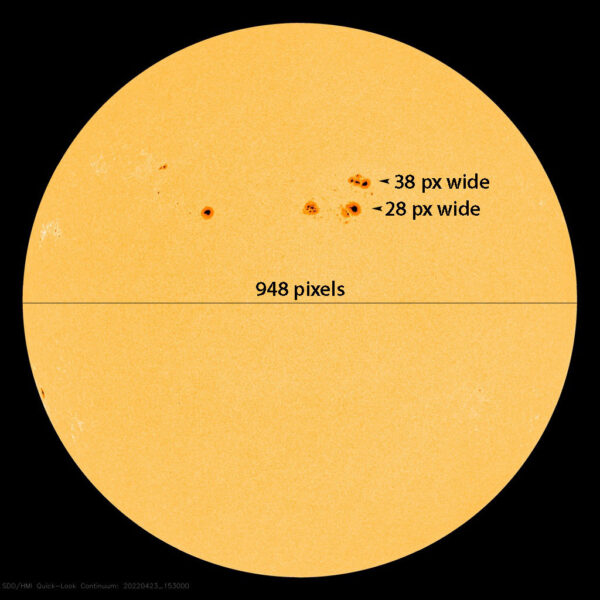
NASA / SDO
In the SDO visible-light image the Sun's apparent size varies from about 966 pixels (32.5′) at perihelion in January to 935 pixels (31.5′) at aphelion in July and approximately 32′ around the equinoxes. Given that the Earth is 1/109 the diameter of the Sun, an Earth-size sunspot would span about 8.9 pixels (966 divided by 109) in January, 8.7 pixels (952/109) at the equinoxes, and 8.6 (935/109) pixels in July.
With those numbers in hand it's a cinch to make ballpark estimates of sunspot sizes. Divide the measured spot size by 8.6, 8.7, or 8.9 to solve for Earth diameters. Using the image above (taken in April) as an example:
28 pixels divided by 8.7 pixels = 3.2 Earths = ~ 40,800 kilometers (25,300 miles)
Grab your pixel ruler
Let's demonstrate how it's done using Photoshop Elements. Open an HMI image, then choose Rulers from the View menu. You'll see a pair of rulers measuring pixels that meet at the zero point in the upper left corner. Enlarge the image (Ctrl+) so the selected sunspot is big enough for a precise measurement. Select the brush tool. Move your pointer to the zero point, press down, and drag. You'll see a cursor that defines the new zero point. Place it at one end of the sunspot and release the mouse.
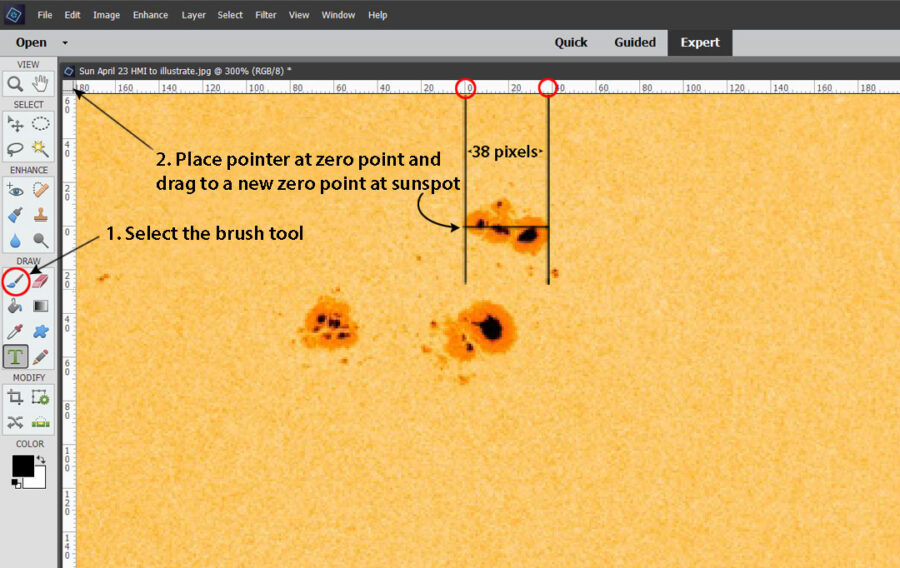
Bob King
Next, hold down the shift key as you press and drag the mouse to other end of the sunspot. Read off pixel length on the ruler above. Divide that by the Earth's pixel diameter (according to the season), and you'll get the spot's size in Earth diameters or fraction thereof. To convert to miles, multiply the number by 7,918 (Earth's diameter) or 12,743 for kilometers.
You can also use the simple, image-measuring software ImageJ for Windows or Mac. Or jettison the software altogether and go analog. Print out the SDO image and measure the diameter of the Sun and sunspot with a ruler. Then divide the spot size into the disk size and multiply exactly as above but using millimeters instead of pixels.
Deeper dive
Remember that this method gives a good approximation of sunspot size. For better sunspot size estimates no matter a group's location on the disk, you'll need to account for foreshortening. Peter Meadows, assistant director of the BAA Solar Section, offers instruction and software to help you accomplish this.

NASA / SDO
Even if you don't make measurements I encourage you to observe naked-eye sunspots. They provide a visceral sense of the Sun's scale, while tracking them reveals that our star rotates. Use the SDO photos as a guide for likely candidates. Record your observations with simple sketches or better, take pictures of the Sun with a telephoto lens outfitted with a screw-on safe solar filter. With a small investment of time — a minute each sunny day — you might be surprised at how many you'll see.
As always, safety first! And if you plan to use older eclipse glasses, make sure you check to see that they're still viable before using them. Never look directly at the Sun without proper eye protection.
Additional resources:
* Stonyhurst Disks — The Sun's axis is tipped 7.25°, making it appear to nod slightly up and down during the year. These monthly disk blanks from the Stanford Solar Center will show the Sun's correct orientation should you choose to sketch sunspots.
* British Astronomical Association Solar Section
Time for something completely different
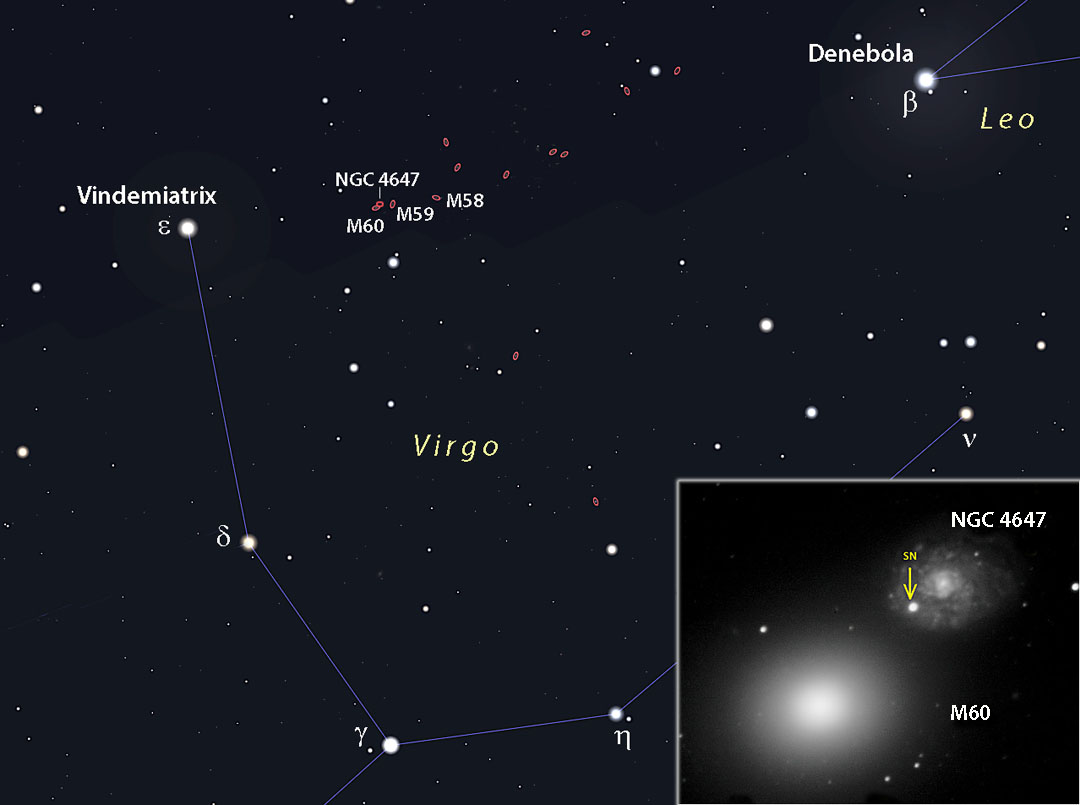
Stellarium / Inset photo by Eliot Herman
A bright supernova recently appeared in the small galaxy NGC 4647, which forms an interacting pair with M60 in northern Virgo. Discovered on April 16th by Japanese observer Koichi Itagaki, the Type Ia object, dubbed SN 2022hrs, has steadily climbed from magnitude 15.0 to its current 12.6.
With M60 as your guide, the host galaxy is easy to find. More good news — the supernova is located 30″ east and 19″ south of the center of NGC 4647, far enough from the core to stand out boldly. I found it with ease in my 15-inch on April 21st, then at magnitude 13.3. For current information on the supernova's status and lots more photos, visit David Bishop's Latest Supernovae site.
 8
8









Comments
Rod
April 27, 2022 at 6:11 pm
Very good report Bob King. On 16-April, I viewed the sun using my 90-mm refractor telescope. 2993 and 2994 were just coming into view in the NE limb. Here is a note from my log 🙂 [Observed 1200-1300 EDT/1600-1700 UT. I used my 90-mm refractor telescope with TeleVue 32-mm plossl for 31x views using glass, white light solar filter. Celestron #12 Yellow and #23A red filters used too. Some easy and very good views of the Sun and sunspots today. AR2990 showed 4 distinct small dark cores, AR2989 one distinct small core, AR2991 a dark core almost earth size with much plage area. There are two much larger dark core sunspots emerging near the solar limb and need a number assigned. They are larger than earth size sunspots with plage areas visible. Spaceweather.com reports "THE BIG SUNSPOTS HAVE ARRIVED: An active sunspot group is emerging over the sun's northeastern limb. There are at least two dark cores larger than Earth, with a possibility of more spots trailing behind. This sunspot group has been very active, hurling CMEs and plumes of plasma over the edge of the sun." My telescope view resolved to 9.6 arcsecond size on the Sun, Earth size on the Sun ~ 17.5 arcsecond. The Sun’s angular size ~ 31.89 arcminute. Telescope true FOV ~ 96 arcminute. Some cirrus moved by the FOV quickly while I observed. Sunny skies, temperature 22C, winds SW/15 knots.]
You must be logged in to post a comment.
Bob KingPost Author
April 27, 2022 at 8:32 pm
Thanks, Rod! And thank you for sharing your report on these sunspot groups, which have been a real highlight for both small telescope and naked-eye observers the past couple weeks.
You must be logged in to post a comment.
Joe Stieber
April 29, 2022 at 12:35 pm
Thanks for the heads-up on the SN Bob! I was down to Belleplain State Forest, NJ, for the South Jersey Star Party last night (April 28, 2022) and it was an easy visual object for my 16-inch dob. Several fellow observers found it in their scopes too (a 15-inch and a 12-inch visually, and a small EV scope got a nice image of it). Tonight or tomorrow night, I'll try for it my 115 mm spotting scope.
You must be logged in to post a comment.
Bob KingPost Author
April 30, 2022 at 12:35 pm
Hi Joe,
Awesome! Glad you got a good look. It's a bright one for sure. As long as you have a 16-inch, check out the 14.7 mag. (Type Ia, discovered 4/12) supernova 2022hkc in UGC 3944 in Lynx. It's located "in the clear" at 16" east and 8" south of the galaxy's center.
You must be logged in to post a comment.
John-Murrell
April 30, 2022 at 6:55 am
A couple of other sites that have images worth checking are the Big Bear Solar Observatory at http://www.bbso.njit.edu/cgi-bin/LatestImages and alto the Observatorium Kanzelhöhe (Austria) at https://www.kso.ac.at/index_en.php which has images in visible, H alpha, Calcium II and drawings of the Sun.
Being Ground based they can only observe when it is clear of course. The images are in near real time though the drawing is only updated once per day.
There are also other telescopes in the GONG network that publish various near live images on the web
You must be logged in to post a comment.
Bob KingPost Author
April 30, 2022 at 12:31 pm
Hi John,
Thank you for mentioning these other sites. I'm sure our readers will find them useful. The Web is rich with solar imagery, it's true! I chose SDO as a primary source because of the frequency of the images and guarantee of a "clear sky" every day.
You must be logged in to post a comment.
Chris-Schur
May 1, 2022 at 6:11 pm
Great info Bob. I also tried to see that nice triple group in late April, and I managed to JUST be able to. I saw them as one grey blob using my ND5 Baader solar filter for my Questar held over both eyes. One thing I did notice - using both eyes really makes a difference! Its like the advantage with binoculars, two eyes minimizes the "noise" my antique eyes produce for a more distinct detection. Another thing I tried, was a polyester filter that produced an orange image. Nichts. Apparently my eyes dont like that color!
You must be logged in to post a comment.
Bob KingPost Author
May 3, 2022 at 11:14 am
Hi Chris,
Glad you spotted the spot! I find the same — two eyes are much better than one. Relaxed eyes see more. I also didn't see the sun as sharply through a nice pair of mylar (orange) filter glasses. The welder's glass gives a sharper view, at least for me.
You must be logged in to post a comment.
You must be logged in to post a comment.